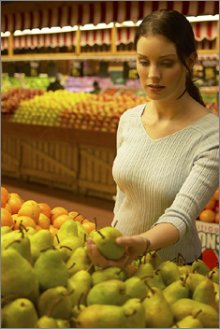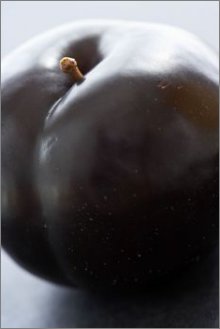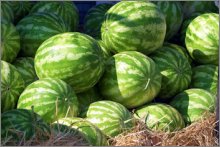|
|

|

How to Choose the Best Fruit in the Produce Section:
A Guide for 15 Common Fruits
by www.SixWise.com For something that seems so simple, buying fruit can be deceivingly
complex. That's why if you look closely at most any grocery
store produce section you'll notice people squeezing, sniffing
and examining their fruit very carefully.
|

When it comes to picking ripe fruit, choosing one that's
heavy for its size is often a better indicator of ripeness
than color.
|
Depending on whom you ask, a watermelon is "ready"
when you knock on it and it sounds hollow. Others swear it's
only worth buying if it makes a thumping sound. Likewise for
cantaloupes. Should a ripe one be soft? Smell sweet? Have
no green patches?
Finally, we have compiled a comprehensive ripeness guide
for some of the most common fruits, so you never have to come
home with a bland pear or sour strawberry ever again!
-
Oranges: When looking for a ripe orange, don't
worry about color. Oranges with green or brown patches
can be just as ripe (and some very orange oranges are
even injected with food coloring to get that bright color).
For the best flavor, look for a firm, heavy orange with
a thin, smooth skin.
-
Watermelon: How do you find the sweetest watermelon
when opting for a whole melon (with cut pieces, look for
deeply colored flesh)? Choose a firm, heavy watermelon
with a smooth skin -- and be sure it has a well-defined
yellow area on one side. This is the spot where the watermelon
has been resting while ripening, and if it's not there
it means it may have been harvested too soon.
-
Grapefruits: Like oranges, don't judge a grapefruit
by its color. Instead, look for heavy, thin-skinned fruits
that are firm but slightly springy when pressed. Avoid
those with thick, rough skins or overly soft spots.
-
Cantaloupe: Be choosy when picking a cantaloupe
because they're often picked while still unripe so they're
not damaged during shipping. You can spot an unripe cantaloupe
by its green tones. Instead, look for a cream-colored
cantaloupe (with no green patches) that has a slightly
soft end (the end opposite the stem). Also, give it a
sniff and choose one that smells slightly sweet (but not
overly so, which could mean it's too ripe).
|

A ripe plum should have a deep color and a slightly
soft tip.
|
-
Apples: A ripe apple will be firm and deeply
colored. Depending on the variety, there should also be
a slight rosy tone (such as with yellow and green apples).
If you want to find apples with the best flavor, buy them
during apple
season, which spans from late summer to early winter.
-
Strawberries: Strawberries are ripe when they're
a deep red color with a shiny skin. Avoid buying any with
green or yellow patches, as they're unripe (and won't
ripen any further). Also stay away from very large strawberries.
Though they look tempting, their flavor is often inferior
to smaller berries.
-
Pears: Most pears in the supermarket are not
yet ripe, so choose those that are firm (but not extremely
hard) and free from dark soft spots (brown speckles, though,
are OK and may signify a better flavor). Once you get
the pears home, leave them on the counter to ripen for
a few days (or put them in a paper bag to speed things
up).
-
Pineapple: Like strawberries, pineapples don't
continue to ripen once they're picked. You can find a
ripe pineapple by choosing one that's heavy for its size
and has a sweet smell (particularly near the stem). Avoid
those that have soft spots or dark patches.
-
Grapes: Ripe grapes are firm and smooth and should
still be attached to the stem. Green grapes with a yellowish
cast will be sweeter, as will deeply colored red and purple
grapes.
-
Bananas: Ripe bananas are, of course, yellow,
but it's OK to buy them while they're still green if you
don't plan on eating them for a few days. What many people
do not know is that you can actually refrigerate ripe
bananas to extend their freshness (the peel will darken,
but the flesh won't be affected). Do not put unripe (green)
bananas in the refrigerator, though -- this will interrupt
the ripening process.
|

Don't pick a watermelon without a rough yellow patch
(the spot where it rested before harvest) -- if it's
missing it could mean the watermelon was picked too
early.
|
-
Kiwi: A kiwi is ripe when it gives slightly when
pressed. Those that are too hard will not be sweet, while
those that are too soft or shriveled are spoiled.
-
Papaya: Papayas with a red-orange skin are ripe
and ready to eat. Those with yellow patches are still
fine, but will take a few days to ripen. Avoid papayas
that are green or very hard, as they're not fully ripe
and won't have a sweet flavor.
-
Plums: The best plums are those that yield slightly
to pressure and have a deep color and semi-soft tip. Plums
that feel firm will ripen in a few days, but avoid those
that are rock-hard, as they may have been harvested too
soon to fully ripen.
-
Blueberries: Look for blueberries
that are firm, dry and brightly colored. Pass up those
that are watery, moist or dull in color.
-
Mangoes: Finding a ripe mango can be tricky because
they can be yellow, red, green or orange in color. Those
that are ready to eat will usually have a yellow hue and
should be slightly soft to the touch. Ripe mangoes also
have a sweet aroma near the stem end.
Recommended Reading
10
Delicious, Nutritious Fruits You've Likely Never Heard of
That Are Growing in Popularity
The
Power of the Pomegranate: The 9 Health Benefits of this Wonder
Fruit, and How to Eat Them
Sources
The World's
Healthiest Foods
To get more information about this and other highly important topics, sign up for your free subscription to our weekly SixWise.com "Be Safe, Live Long & Prosper" e-newsletter.
With every issue of the free SixWise.com newsletter, you’ll get access to the insights, products, services, and more that can truly improve your well-being, peace of mind, and therefore your life!
|
|
|
|